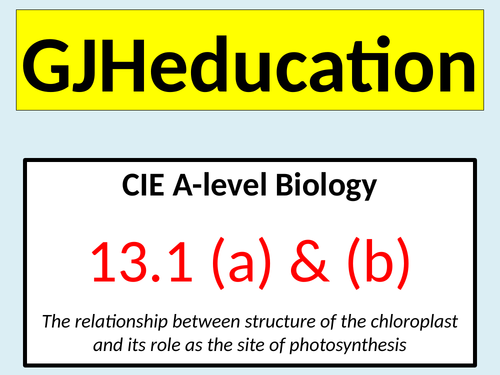





This lesson describes the structure of the chloroplast, focusing on the sites of the light-dependent and light-independent stages of photosynthesis. This fully-resourced lesson, which consists of an engaging PowerPoint and accompanying resources, has been designed to cover points 13.1 (a) & (b) of the CIE A-level Biology specification and has been specifically designed to introduce students to the grana and stroma as the site of the light-dependent and light-independent stages respectively before they are covered in greater detail in the lessons that are taught later in topic 13.1.
Students were introduced to eukaryotic cells and their organelles in topic 1 so this lesson has been written to test and to build on that knowledge. A version of the quiz show POINTLESS runs throughout the lesson and this maintains engagement whilst challenging the students to recall the parts of the chloroplast based on a description which is related to their function. The following structures are covered in this lesson:
- double membrane
- thylakoids (grana)
- stroma
- intergranal lamellae
- starch grains
- chloroplast DNA and ribosomes
Once each structure has been recalled, a range of activities are used to ensure that key details are understood such as the role of the thylakoid membranes in the light-dependent reactions and the importance of ATP and reduced NADP for the reduction of GP to TP in the Calvin cycle. Links to other topics are made throughout and this is exemplified by the final task of the lesson where students are challenged on their recall of the structure, properties and function of starch, as originally covered in topic 2.2
Get this resource as part of a bundle and save up to 37%
A bundle is a package of resources grouped together to teach a particular topic, or a series of lessons, in one place.
Topics 12 & 13: Respiration and photosynthesis (CIE A-level Biology)
Respiration and photosynthesis are two of the most commonly-assessed topics in the terminal A-level exams but are often poorly understood by students. These 14 lessons have been intricately planned to contain a wide range of activities that will engage and motivate the students whilst covering the key detail to try to deepen their understanding and includes exam-style questions so they are fully prepared for these assessments. The following specification points in topics 12 and 13 of the CIE A-level Biology course are covered by these lessons: * The need for energy in living organisms * The features of ATP * The synthesis of ATP by substrate-level phosphorylation in glycolysis and the Krebs cycle * The roles of the coenzymes in respiration * The synthesis of ATP through the electron transport chain in the mitochondria and chloroplasts * The relative energy values of carbohydrates, lipids and proteins as respiratory substrates * Determining the respiratory quotient from equations for respiration * The four stages of aerobic respiration * An outline of glycolysis * When oxygen is available, pyruvate is converted into acetyl CoA in the link reaction * The steps of the Krebs cycle * Oxidative phosphorylation * The relationship between the structure and function of the mitochondrion * Distinguish between aerobic and anaerobic respiration in mammalian tissue and in yeast cells * Anaerobic respiration generates a small yield of ATP and builds up an oxygen debt * The products of the light-dependent stage are used in the Calvin cycle * The structure of a chloroplast and the sites of the light-dependent and light-independent stages of photosynthesis * The light-dependent stage of photosynthesis * The three stages of the Calvin cycle * The conversion of Calvin cycle intermediates to carbohydrates, lipids and amino acids * Explain the term limiting factor in relation to photosynthesis * Explain the effects of changes in light intensity, carbon dioxide concentration and temperature on the rate of photosynthesis * Explain how an understanding of limiting factors is used to increase crop yields in protected environments Due to the detail of these lessons, it is estimated that it will take up to 2 months of allocated A-level teaching time to cover the detail included in the slides of these lessons If you would like to sample the quality of the lessons, download the roles of the coenzymes, the Krebs cycle and the products of the Calvin cycle lessons as these have been shared for free
Topic 13: Photosynthesis (CIE A-level Biology)
This bundle contains 5 fully-resourced lessons which are highly detailed and will engage and motivate the students whilst the following content that is set out in topic 13 of the CIE A-level Biology specification is covered: Topic 13.1 * Energy transferred as ATP and reduced NADP from the light dependent stage is used during the Calvin cycle to produce complex organic molecules * The sites of the light-dependent and light-independent stages of photosynthesis * The light-dependent stage as the photoactivation of chlorophyll, the photolysis of water and the transfer of energy to ATP and reduced NADP * Cyclic and non-cyclic photophosphorylation * The three main stages of the Calvin cycle * The conversion of Calvin cycle intermediates to carbohydrates, lipids and amino acids Topic 13.2 * Explain the term limiting factor in relation to photosynthesis * Explain the effects of changes in light intensity, carbon dioxide concentration and temperature on the rate of photosynthesis * Explain how an understanding of limiting factors is used to increase crop yields in protected environments The lesson PowerPoints and accompanying resources contain a wide range of tasks which include exam-style questions, whole class discussion periods and quiz competitions which are designed to introduce key terms and values in a memorable way.
Something went wrong, please try again later.
This resource hasn't been reviewed yet
To ensure quality for our reviews, only customers who have purchased this resource can review it
Report this resourceto let us know if it violates our terms and conditions.
Our customer service team will review your report and will be in touch.